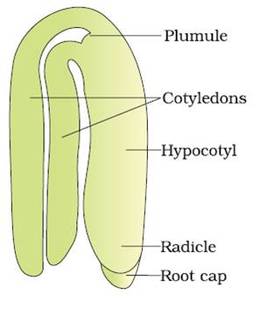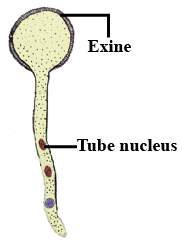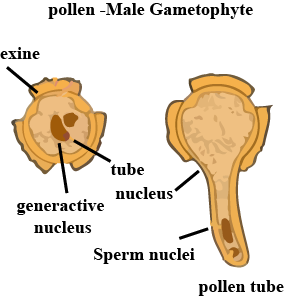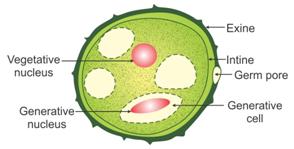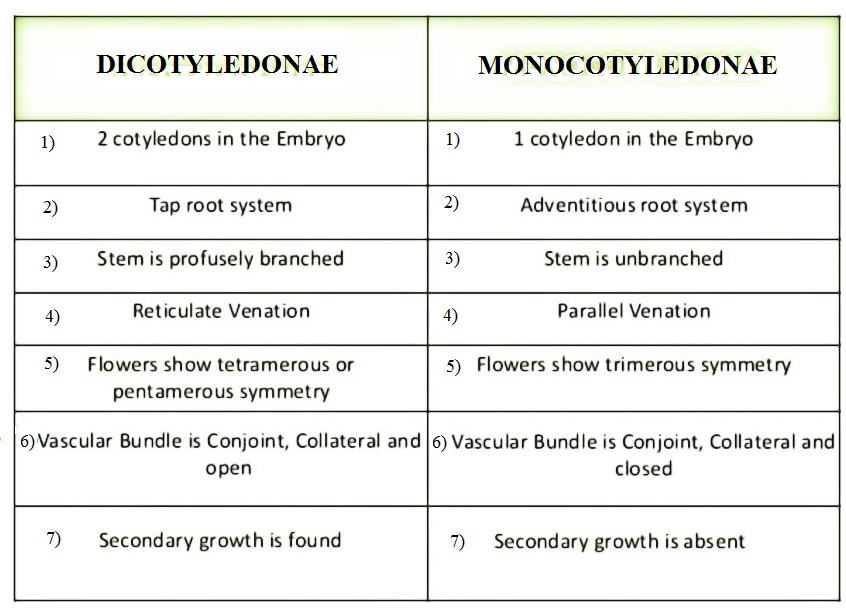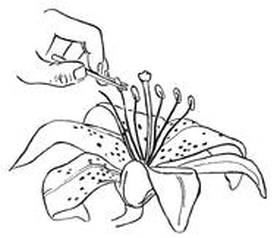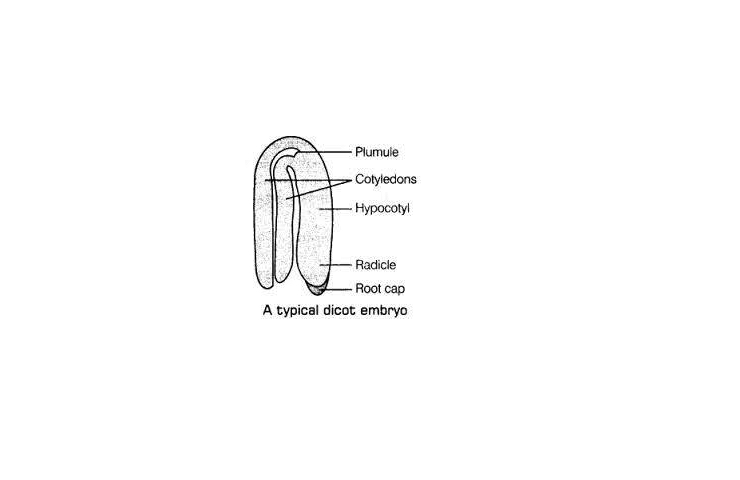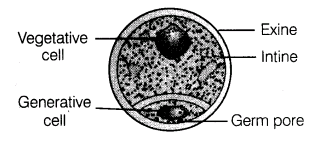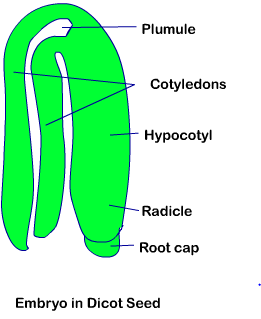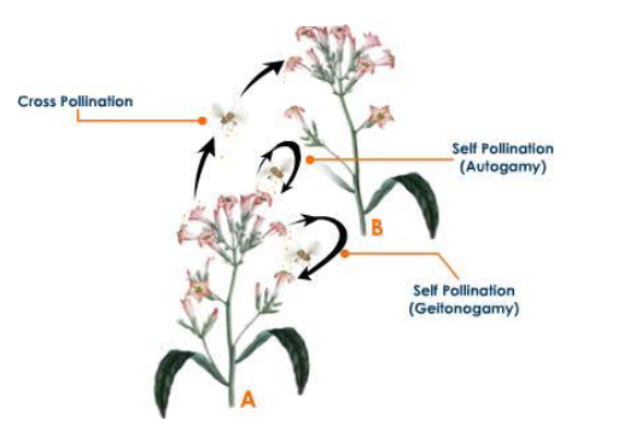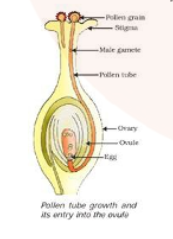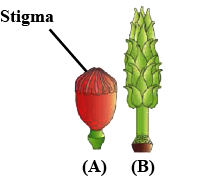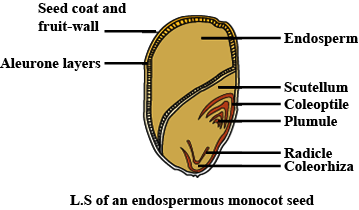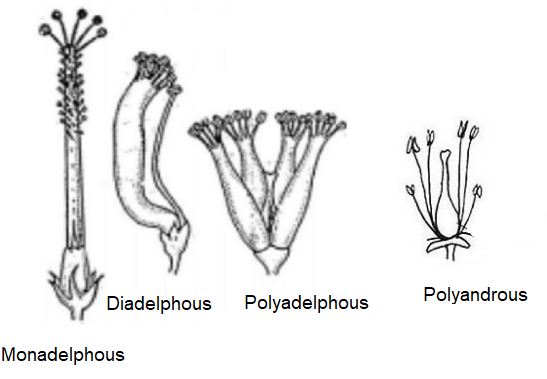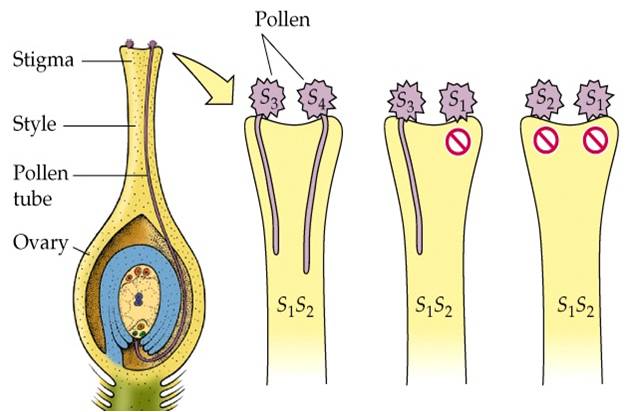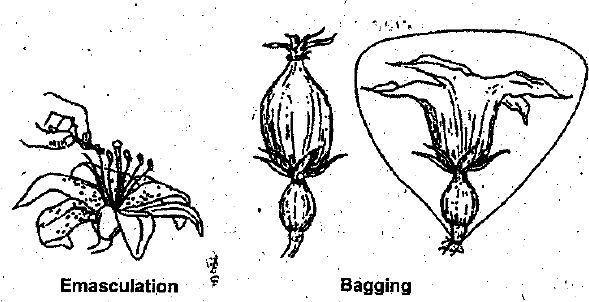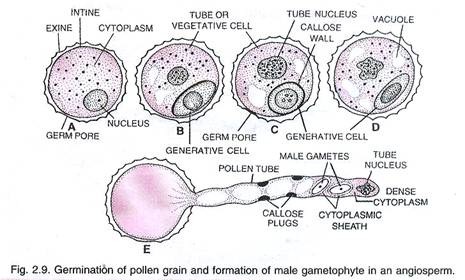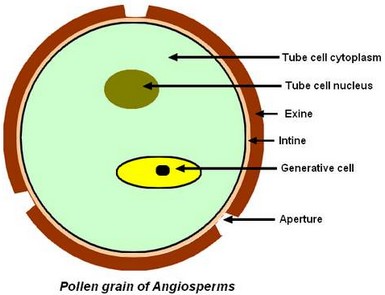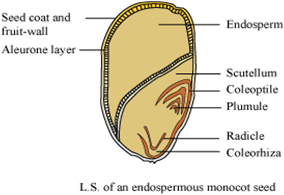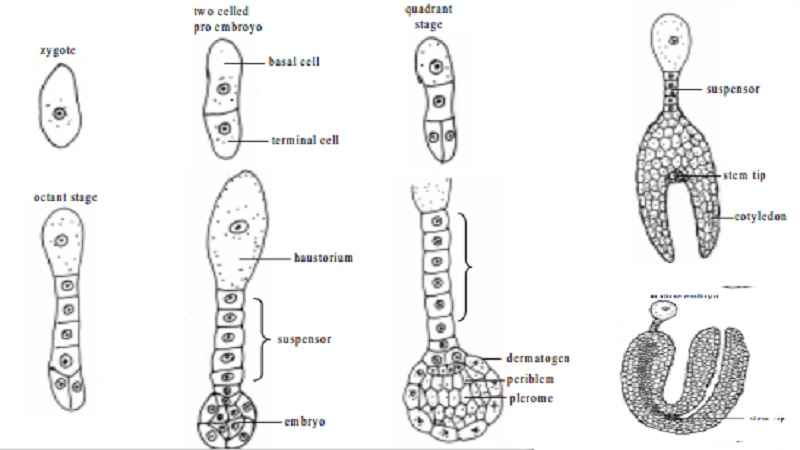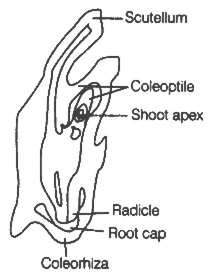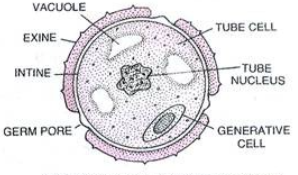Sexual Reproduction In Flowering Plants - Class 12 Medical Biology - Extra Questions
(a) Name the part marked. 'A' in the diagram.(b) How does 'A' reaches part 'B'?(c) State the importance of the part 'C'.(d) What happens to the part marked 'D' after fertilisation is over?
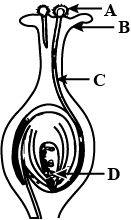
(b) How does 'A' reaches part 'B'?
(c) State the importance of the part 'C'.
(d) What happens to the part marked 'D' after fertilisation is over?
What is a false fruit? Cite an example.
Why is the apple referred to as a false fruit?
Define Geitonogamy.
Pollination of flowers by birds.
How is pollination different from fertilisation?
Name the part of the flower which the tassels of the corn-cob represent.
State one advantage and one disadvantage of cleistogamy.
How does 'A' reaches part 'B'?
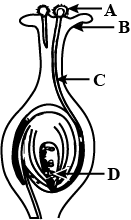
(a) Explain the different ways apomictic seeds can develop. Give an example of each.
(b) Mention one advantage of apomictic seeds to farmers.
(c) Draw a labelled mature stage of a dicotyledonous embryo.
Why is apple called a false fruit? Which part(s) of the flower forms the fruit?
(a) Plan an experiment and prepare a flow chart of the steps that you would follow to ensure that the seeds are formed only from the desired sets of pollen grains. Name the type of experiment that you carried out.
(b) Write the importance of such experiments.
State what is apomixis. Comment on its significance. How can it be commercially used?
Geitonogamous flowering plants are genetically autogamous but functionally cross-pollinated. Justify.
What is bagging technique? How is it useful in a plant breeding programme?
What is apomixis and what is its importance?
Mention the most significant function of each of the following.
(i) Tapetum cells
(ii) Serotonin
(iii) Lenticels
(iv) Cerebrospinal fluid
(v) Islets of Langerhans
(vi) Bundle sheath
How bisexual and unisexual conditions in plants are denoted?
Redraw the diagram and label the following parts.
(a) Exine
(b) Tube nucleus

Why do pollen grains remain preserved for long time ?
Draw the given diagram and label the following parts:
(i) Exine (ii) Tube nucleus
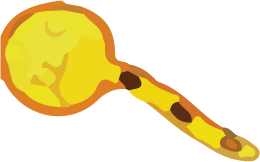
What is emasculation?
Briefly explain the structure of pollen grains.
Explain the process of pollination in Vallisneria. How is it different in water-lily, which is also an aquatic plant?
Pollen grains in wheat are shed at "3-celled stage while in peas they are shed at 2-celled stage." Explain. Where are germ pores in a pollen grain?
Pollination takes place by the agency of bird is known as
What is pollination? List out biotic and aboitic factors which are involved in pollination?
Albuminous seeds store food materials in ___________.
Distinguish between apocarpous and syncarpous ovary.
A farmer has two fields A and B. He cultivates peas (Pisum sativum) in both the fields. Field A is covered with nets to keep out birds and insects. Field B is left uncovered.
(i) Name the type of pollination that would occur in field 'A' and field 'B'.
(ii) Which of these fields will give a higher yield?
(iii) To raise the next crop, from which field should the seeds be chosen by the farmer. Give reasons to support your answer.
Describe the outbreeding devices that prevent the autogamy.
Sunflower is pollinated by insects while rice is pollinated by wind. Plants can be self or cross-pollinated. Write any two mechanisms existing in nature to promote cross- pollination.
Three different flowers are given to you in the practical class.
(i) Maize
(ii) Vallisneria
(iii) Rose
You are asked to group them based on pollinating agents. Describe the adaptions of each flower related with the agents of pollination.
Sunflower is pollinated by insects while rice is pollinated by the wind. How are these plants adapted to their respective type of pollination method?
Why are petals colorful?
How do insects, butterflies, honeybees, and birds help Angiosperms?
Define the term epipetalous stamen.
Describe the various modes of fixation of anther over filament.
What is parthenogamy ?
Sketch and label a pollen grain of angiosperms.
Write the male part of flower.
Give a reason for the following.
Pollen grains of wind pollinated flowers are produced in large quantities.
Write a short note on polyembryony.
Given alongside is a diagrammatic sketch of the sectional view of a plant part relating to reproduction.
(a) Identify the plant part as a whole.
(b) Name the structural parts numbered 1-5.
(c) Where would it be found as a stage as shown?
(d) What is the function of part 4?
(e) What immediately next happens to the part 5?
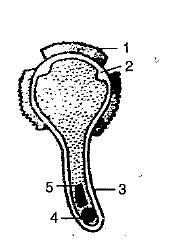
State the name of the chief pollinating agent against the corresponding plant by choosing from those given in brackets
Maize_______(Bees, locusts, rain, wind).
Give any two examples each of endospermic (albuminous) seeds and non-endospermic (exalbuminous) seeds.
State the name of the chief pollinating agent against the corresponding plant by choosing from those given in brackets.
Vallisneria____(Wind, water, ants, rabbits).
Give the technical terms for the following :
Pollination of flowers by insects.
Explain the following term : Artificial pollination
Germinated grams are considered highly nutritive. What is the reason for this belief?
Write two ways in which pollination may occur in plants.
Explain the following term : Elephophily.
Fill in the blanks with appropriate words.
The formation of more than one embryo from the zygote is called..........
The formation of more than one embryo from the zygote is called..........
What is pollination? Describe the pollination brought through the agency of insects and explain with suitable examples the adaptations of plants for this type of pollination.
Differentiate between wind and insect-pollinated flowers.
Why is necessary to emasculate a bisexual flower in a plant breeding programme? Mention the condition under which emasculation is not necessary.
In what ways does the study of pollination enrich our understanding of biology and enable us to apply it for increasing crop productivity?
Differentiate between.
Autogamy and geitonogamy.
Differentiate between.
True and false fruit
Explain why emasculation and bagging are practised during artificial hybridisation prorgamme involving plants bearing bisexual flowers.
Describe apomixis and it's significance in plants.
Normally one embryo develops in one seed but when an orange seed is squeezed many embryos of different shapes and sizes are seen. Mention how it has happened.
Wind-pollinated flowers are not visited by honey bees. Give two reasons.
What is pollination? Mention any four features of wind pollinated flowers.
Mention the pollinating agent of an inflorescence of small dull-coloured flowers with well-exposed stamens and large feathery stigma. Give any one characteristic of pollen grains produced by such flowers.
Define anemophily.
Why is tender coconut considered a healthy source of nutrition?
Why does endosperm development precede embryo development in angiosperm seeds? State the role of endosperm in mature albuminous seeds.
Describe endosperm development in coconut.
Two mark Questions:
Banana is a parthenocarpic fruit whereas oranges show polyembryony.How are they different from each other with respect to seeds?
Two mark Questions:
Suggest two advantages to a farmer for using apomictic seeds of hybrid varieties.
Answer in brief:
Why does a pollen grain possess two male gametes?
A flower of tomato plant following the process of sexual reproduction produces 240 viable seeds. Answer the following questions giving reasons :
What is the minimum number of pollen grains that must have been involved in the pollination of its pistil?
Differentiate between albuminous and nonalbuminous seed, giving one example of each.
Why is geitonogamy also referred to as genetical autogamy?
Pistil of a flower does not accept pollen from any plant other than from its own kind. How does it happen?
Explain the following terms : polyembryony
List the different types of pollination depending upon the source of the pollen grain.
What is polyembryony?
Mention the ploidy levels of the cells of different parts of an albuminous seed.
What is apomixis? Mention its significance.
Suggest some advantages and disadvantages of self-pollination to a species of plant.
Give the property of stigma due to which it receives the pollen grains
Which type of pollination takes place in self-incompatible flowers?
Describe the technique of emasculation.
Based on the type and location of storage materials, how many types of seeds are there? What are they? Give examples.
Differentiate between Albuminous and non albuminous.
Give one example of endospermic dicot seed and non-endospermic seed.
What is oogamy?
Define apomixes. Mention two ways in which apomictic seed develop.
Distinguish between dicotyledonae and monocotyledonae.
Define emasculation.
A farmer maintained beehives in his Brassica field during its flowering season.How will he be benefitted?
Why should a bisexual flower be emasculated and then bagged prior to artificial pollination in hybridization programs?
Define autogamy.
(a) Identify the figure.
(b) Name the initial cell from which this structure has developed
(c) Draw the next mature stage and label the parts.
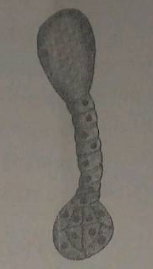
Name the seeds where remnants of nucellus can be found in the seeds ?
What is the pollen basket?
The exine of pollen grain is hard and resistance to enzyme action. Give reason.
How is artificial pollination useful to plant breeders? Discuss briefly.
What is called filiform apparatus?
What are the sexual parts in the flower?
In case of polyembryony an embryo A develops from the synergids and the embryo B develops from the nucellus. State the ploidy of embryo A and B
Name the male and female reproductive parts in plants.
Draw the diagram of microsporangium of an Angiosperm and label any four parts. State the function of its innermost wall layer.
Why should a bisexual flower be emasculated and then bagged prior to artificial pollination in hybridisation programmes?
Emasculation is not required when flowers are?
Both wind and water pollinated flowers are not very colourful and do not produce nectar. What would be the reason for this ?
Viability means
What is pollination? State its significance.
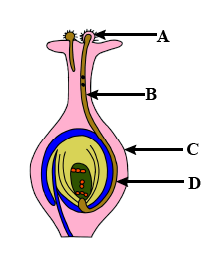
Name the parts labelled as A, B, C and D in the diagram given.
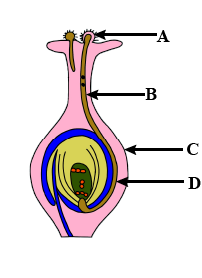
What is pollination?
Some angiosperm seeds are said to be 'albuminous', whereas few others are said to have a perisperm, Explain each with the help of an example.
What is meant by emasculation ? How is it useful in plant breeding programme?
Some species of plants are self-pollinated. Discuss the long-term effect of self-pollination on the evolution of these plants.
Define apomixis.
What does pollen tube carry?
Why do we use sucrose as the medium for pollen germination?
State the function of plumule and cotyledon of embryo of a dicot seed.
It is said apomixis is a type of asexual reproduction. Justify.
List the parts of a typical dicot embryo.
Define pollination. Explain the different types of pollination. List two agents of pollination? How does suitable pollination lead to fertilization?
Complete the following chart and rewrite :
| Sr. No. | Agencies | Type of Pollination |
| 1. | Water | ...... |
| 2. | ... | Entomophily |
| 3. | Bat | ..... |
| 4. | ..... | Omithophily |
Stamen has two parts called ______ and ______.
State the appropriate terms for the following:
Plants which bear seeds with two cotyledons.
i) What is meant by pollination?ii) what are its two types?iii) what are the agents which help in pollination?
What do you mean by true fruit and false fruit?
Briefly explain pollination?
Very Short Answer.
Rearrange the following events of sexual reproduction in the sequence in which they occur in a flowering plant : embryogenesis, fertilisation, gametogenesis, pollination
a) Distinguish between pollination and fertilisation. b) Mention the site and product of fertilisation in a flower. c) Draw a neat, labeled diagram of a pistil showing pollen tube growth and its entry into the ovule.
"Identify if the statement is right, if not, correct it."
Anther is a part of the pistil.
Differentiate between Pollen and Pollinium.
Are pollination and fertilisation necessary in apomixis? Give reasons.
Identify the type of carpel with the help of diagrams given below:
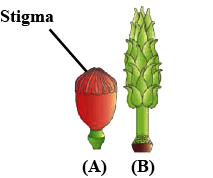
Can an unfertilised, apomictic embryo sac give rise to a diploid embryo? If yes, then how?
What is self-incompatibility?
Given below are the events that are observed in an artificial hybridization programme. Arrange them in the correct sequential order in which they are followed in the hybridization programme.
(a) Re-bagging
(b) Selection of parents
(c) Bagging
(d) Dusting the pollen on stigma
(e) Emasculation
(f) Collection of pollen from male parent
Name the part of gynoecium that determines the compatible nature of pollen grain.
Which are the three cells found in a pollen grain when it is shed at the three celled stage?
In case of polyembryony, if an embryo develops from the synergid and another from the nucellus which is haploid and which is diploid?
List three strategies that a bisexual chasmogamous flower can evolve to prevent self-pollination (autogamy).
What are the possible types of pollinations in chasmogamous flowers. Give reasons.
What is a ‘false fruit’? Give one example.
Name the three agents of pollination.
Embryo sacs of some apomictic species appear normal but contain diploid cells. Suggest a suitable explanation for the condition.
Draw a diagram of longitudinal section through a monocot seed
Are parthenocarpy and apomixis different phenomena? Discuss their benefits.
What is emasculation? Why and when is it done?
Does self-incompatibility impose any restrictions on autogamy? Give reasons and suggest the method of pollination in such plants.
What is polyembryony and how can it be commercially exploited?
Distinguish between the following pairs: Polyandrous and Polyadephous androecium
Pollination is the process of transfer of _________
Name the different types of androecium found in flowers.
Explain the terms Monadelphous, Diadelphous and Polyadelphous. In each case name a flower possessing such an androecium.
Different timings for maturation of gynoecium and androecium, is called _______.
Why are the following describes as stated:
(a) The androecium of pea flower is diadelphous
(b) Ray florets of sunflower as neuters
(c) In Salvia sepals as petaloid
Give any two examples each of endospermic (albuminous) seed, and non-endospermic (exalbuminous) seeds.
When pollen grains of a flower reach the stigma of the same flower
Name the type of androecium found in
(a) China rose
(b) Bombax
(c) Pea
Transfer of pollen grains from anthers to stigma of the same flower is called ______.
Pollination of flowers by insects
From where does developing embryo gets nutrition?
Write in detail, the structure of pollen grain.
What are Ubisch bodies?
Why pollen grains are conserved for a long time?
Amit visited an orchard where he found some flowers were covered with butter paper bags. He was about to remove the bags, but the gardener did not allow him. Can you say why?
Pick up the correct matchA) A-1, B-2, C-3,D-4B) A-2,B-3,C-4,D-1C) A-3,B-2,C-4,D-1D)A-3,B-4,C-1,D-2
What is pollination? State its types.
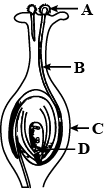
(a) Why does endosperm development precede embryo development in angiosperm seeds? State the role of endosperm in mature albuminous seeds.
(b) Describe with the help of three labelled diagrams the different embryonic stages that include mature embryo of dicot plants.
Two mark Questions:
Name the organic materials the exine and intine of an angiosperm pollen grains are made up of. Explain the role of exine.
Where is sporopollenin present in plants? State its significances with reference to its chemical nature.
Explain the function of each of the following.
(a) Coleorhiza (b) Umbilical cord (c) Germ pores
Identify each part in a flowering plant and write whether it is haploid (n) or diploid (2n).
(a) Ovary
(b) Anther
(c) Egg
(d) Pollen
(e) Male gamete
(f) Zygote
What is self-incompatibility? Why does self-pollination not lead to seed formation in self-incompatible species?
(a) Name the organic material of the exine of the pollen grain. How is this material advantageous to pollen grain?
(b) Still, it is observed that it does not form a continuous layer around the pollen grain. Give reason.
(c) How are 'pollen banks' useful?
(a) How does cleistogamy ensure autogamy?
(b) State one advantage and one disadvantage of cleistogamy to the plant.
Write the difference between chasmogamous and cleistogamous flowers.
Why does white flowers bloom at night?
Describe pollen-pistil interaction in detail.
Imagine you have a garden with the plants listed below. A swarm of bees visited your garden, do you think the bees will visit all the flowers? Name the flowers which you think the bees will be attracted to. Give reasons to substantiate your answer.
(Jasmine, Nerium, Gulmohar, Rose, Lotus, Corn, Sugarcane, Bamboo, Chrysanthemum, Dahlia, Grass, Coconut, and Peas)
What is meant by emasculation? When and why does a plant breeder employ this technique?
With the help of diagrams, describe emasculation and bagging.
Name the agents of pollination in the following cases
(i) Bright coloured flowers with scent and nectar glands.
(ii) No colour/scent/nectar but pollen grains are dry, light weight and powdery. Stigma is feathery.
Also mention the plants in cases (i) and (ii)
Explain the difference between self-pollination and cross-pollination
(unisexual, fertilisation, fruit, stamen, anther, bisexual, pollination, seed, ovary)
Transfer of pollen grains from the anther to the stigma is known as .........
Differentiate between.
Geitonogamy and allogamy
Name the three agents of pollination.
What is meant by pollination? Explain the structure of germinating pollen grain with the help of a labelled diagram.
Differentiate between .
Heartwood and sapwood
Differentiate between.
Mesogamy and porogamy
Differentiate between Hypocotyl and epicotyl.
What is malacophily?
Draw a labelled diagram of the structure of mature dicot embryo.
Describe the structure of pollen grain of angiosperms.
Differentiate between Coleoptile and coleorhiza
Draw a labelled long sectional view of an albuminous seed.
Fertilization is essential for the production of seeds but in some angiospermic seeds develop without fertilization.
Give an example of angiosperm that produces seeds without fertilization. Name the process.
Draw a neatly labelled sketch of L.S. of an endospermous monocot seed.
Starting with the zygote, draw the diagrams of the different stages of embryo development in a dicot.
Why is fossilization of pollen possible?
A flower of tomato plant following the process of sexual reproduction produces 240 viable seeds. Answer the following question giving reasons :
How many megaspore mother cells were involved?
Describe with the help of three labelled diagrams the different embryonic stages that include mature embryo of dicot plants.
Draw a labelled diagram of L.S. of an embryo of the grass.
Shreya was walking along with her young brother Srijjan in the garden. Suddenly Srijjans attention was drawn towards a butterfly that was visiting one flower after another. He asked Shreya what was the butterfly doing. Shreya told her younger brother about honey collection and pollination by a butterfly. What values were highlighted by Shreya?
Explain how some plants are adapted for achieving pollination through wind. How sea - grasses and Vallisneria achieve pollination ?
What is staminode?
Describe the structure of androecium/stamen.
A flower of tomato plant following the process of sexual reproduction produces $$240$$ viable seeds. Answer the following question giving reasons.
What is the minimum number of pollen grains that must have been involved in the pollination of its pistil?
Define pollinations. Explain wind and water pollination with example.
Describe the structure of a pollen grain.
Draw a well labelled diagram of the embryo of a dicot seed. Also write the role of cotyledons.
The exine of pollen grain is hard and resistant to enzyme action. Give reasons.
a) Explain two ways by which apomictic seeds get develop.
b) List one advantage and one disadvantage of a apomictic crop.
c) Why do farmers find production of hybrid seeds costly?
Draw a diagram showing various parts of an embryo of a dicot seeds.
Class 12 Medical Biology Extra Questions
- Biodiversity And Its Conservation Extra Questions
- Biotechnology And Its Applications Extra Questions
- Biotechnology: Principles And Processes Extra Questions
- Ecosystem Extra Questions
- Environmental Issues Extra Questions
- Evolution Extra Questions
- Human Health And Disease Extra Questions
- Human Reproduction Extra Questions
- Microbes In Human Welfare Extra Questions
- Molecular Basis Of Inheritance Extra Questions
- Organisms And Population Extra Questions
- Principles Of Inheritance And Variation Extra Questions
- Reproduction In Organisms Extra Questions
- Reproductive Health Extra Questions
- Sexual Reproduction In Flowering Plants Extra Questions
- Strategies For Enhancement In Food Production Extra Questions
